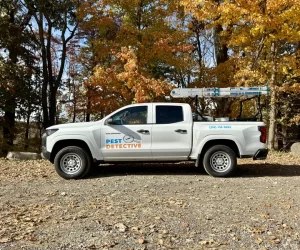Why Choose Our Expert Bed Bug Exterminators?
When it comes to choosing a bed bug exterminator, The Pest Detective stands out. Here’s why:
- Expertise You Can Rely On: Our skilled technicians are extensively trained in bed bug removal and stay updated on the latest extermination methods.
- Customer-Focused Service: We treat your home or business with the care and respect it deserves. Your satisfaction is our top priority.
- Guaranteed Results: Our follow-up treatments and commitment to complete extermination ensure we get the job done right.
- Safe, Effective Solutions: We use treatment methods that are safe for children, pets, and the environment, giving you peace of mind while eliminating pests.
Comprehensive Bed Bug Treatment Plans
Our bed bug treatment process is thorough and tailored to eliminate infestations at the source. We don’t believe in quick fixes that only offer temporary relief. Instead, we follow a proven two-step approach:
- Initial Treatment: Our experts treat your home using advanced techniques to target bed bugs at every stage of their life cycle. This includes applying professional-grade solutions to infested areas, ensuring bed bugs and their eggs are effectively eradicated.
- Follow-Up Treatments: Bed bugs can be persistent, so we schedule follow-up treatments three weeks apart to ensure complete extermination. These visits allow us to monitor progress, treat any lingering bugs, and confirm the infestation is eliminated for good.
By combining experience, precision, and dedication, we ensure your home or business is bed bug-free. Schedule now: Free Bed Bug Inspection
Bed Bug Treatment Process
Our bed bug extermination process is thorough, effective, and designed to eliminate infestations at every stage of their lifecycle. With a meticulous approach, we ensure no bed bug is left behind. Below is a detailed look at how our extermination process works:
Step 1: Inspection and Confirmation
The first step in any bed bug extermination process is confirming the presence of bed bugs in your home or business. Our experienced bed bug exterminators in Cleveland begin with a comprehensive visual inspection of key areas, including beds, furniture, and fabrics. This includes looking for signs such as live bed bugs, eggs, shed skins, or droppings. If the infestation is not immediately visible, we may use bed bug test kits, which offer up to 93% accuracy in detecting bed bugs, even in the early stages of an infestation.
Step 2: Preparation Before Treatment
Before treatment can begin, preparation is crucial to prevent bed bugs from spreading and to ensure the treatment is as effective as possible. Our team will guide you on how to prepare your space, which includes:
- Bagging all fabrics except for couches and beds: Clothing on the floor, in dressers, bedding, window curtains, and other fabrics must be placed in sealed garbage bags.
- Washing and drying on high heat: Once bagged, these items should be taken directly to the washer and set to hot, as bed bugs cannot survive high temperatures.
By properly preparing your space, we can maximize the effectiveness of the treatment and ensure the infestation is confined.
Step 3: Residual Insecticide Application
Once the space is prepared, we begin the treatment by applying residual insecticides to critical areas where bed bugs are known to hide. These insecticides are specially labeled for bed bugs and are applied to:
- Baseboards
- Bed frames
- Dressers and nightstands
- Outlets
- Coffee tables
This residual treatment not only eliminates existing bed bugs but continues to provide protection, killing any bed bugs that come into contact with the treated areas for weeks after application.
Step 4: Insecticidal Dust for Hard-to-Reach Areas
Bed bugs are notorious for hiding in cracks, crevices, and other hard-to-reach areas. To ensure complete eradication, our skilled exterminators utilize insecticidal dust for areas such as:
- Behind wall outlets
- Inside walls
- Cracks in flooring
This dust targets bed bugs in these hidden spaces, effectively eliminating them in areas that traditional sprays may not reach.
Step 5: Alcohol-Based Treatment for Upholstery and Carpets
For the final stage of treatment, we employ alcohol-based treatments using pump sprayers. This method is safe and highly effective for targeting bed bugs in:
- Upholstered furniture
- Carpets and rugs
- Beds and mattresses
This step ensures that even the most stubborn bed bugs are eliminated, leaving your space free of these invasive pests.
Follow-Up Treatments for Long-Term Protection
To fully eradicate bed bug infestations, follow-up treatments are scheduled three weeks apart. These additional treatments target any remaining bed bugs that may have survived the initial application or newly hatched eggs, ensuring the complete elimination of the infestation.
Our multi-step process, combined with industry-leading techniques and products, ensures thorough and effective bed bug extermination, giving you peace of mind and a pest-free home
Use of IGR's in Bed Bug Extermination Process
In our bed bug extermination process, we incorporate insect growth regulators (IGRs) as a vital component for long-term success. IGRs are cutting-edge products that target bed bugs by disrupting their natural development and reproduction cycles. Unlike traditional insecticides that kill on contact, IGRs work at the biological level to prevent future infestations from taking hold.
How Do IGRs Work?
IGRs mimic natural insect hormones, interfering with the life cycle of bed bugs at critical stages. By applying these regulators, we effectively:
- Prevent eggs from hatching: IGRs stop bed bug eggs from developing into nymphs, cutting off the next generation of bed bugs.
- Disrupt nymph development: For younger bed bugs, IGRs halt their ability to mature into adults, reducing their ability to reproduce.
- Stop reproductive cycles: By preventing bed bugs from reaching reproductive maturity, IGRs drastically reduce the population over time.
Why Are IGRs Beneficial in Bed Bug Extermination?
The use of IGRs provides several key benefits:
- Long-Term Protection: While contact insecticides eliminate live bed bugs, IGRs ensure that new infestations cannot take root by halting the growth and reproduction of remaining bed bugs.
- Resistance Management: Some bed bugs have developed resistance to traditional pesticides. IGRs act as an additional layer of protection by targeting the biology of the pest in a way that resistance cannot overcome.
- Safe and Effective: IGRs are safe for use in homes and businesses and work in harmony with the other treatments we employ.
By integrating IGRs into our comprehensive bed bug treatment program, we ensure not only the elimination of current infestations but also a proactive approach to preventing future outbreaks. This multifaceted strategy provides our customers with long-lasting peace of mind and a pest-free environment.
How To Do An At-Home Bed Bug Inspection
Performing an at-home bed bug inspection requires attention to detail. Start by examining mattresses and box springs, focusing on seams, tufts, and edges where bed bugs often hide. Check headboards, bed frames, and nearby furniture, including cracks, joints, and crevices. Inspect fabrics like curtains, rugs, and upholstered furniture for signs of bed bugs or dark stains from their droppings. Use a flashlight to check baseboards, outlets, and behind wall hangings. Look for tiny white eggs, shed skins, or live bed bugs. If you notice these signs, act promptly to prevent further infestation and consider contacting a professional for confirmation and treatment.
How To Identify Bed Bug Bites
Identifying bed bug bites can help you determine if you’re dealing with an infestation. These bites often appear as small, red, itchy welts, typically in clusters or a linear pattern on exposed skin such as the arms, neck, face, or legs. Unlike mosquito bites, bed bug bites may take a few hours or days to develop, and the itching can range from mild to severe. Look for bites that are more prominent in the morning, as bed bugs are nocturnal and feed at night. If you notice recurring bites or patterns, it’s a strong indicator of bed bug activity.

